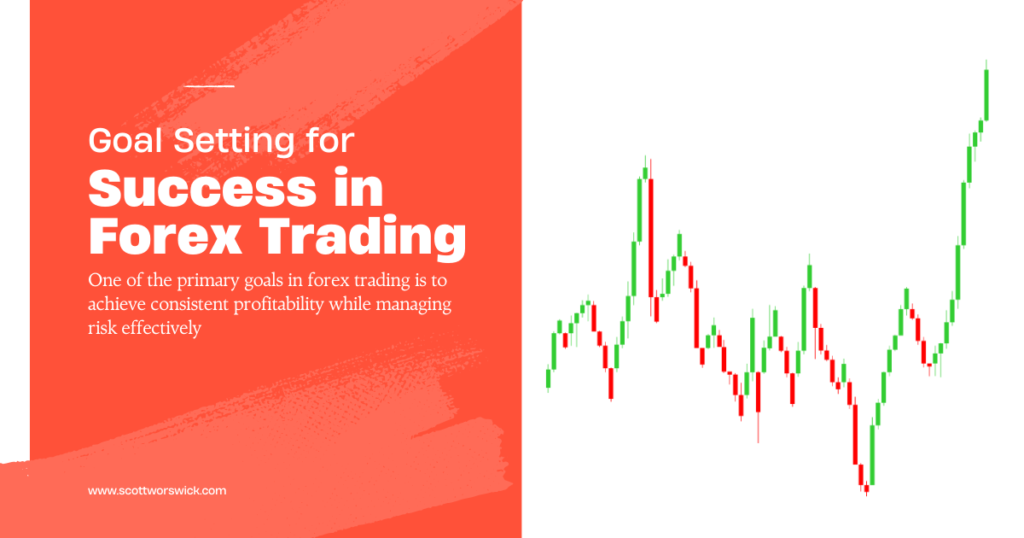In the fast-paced and highly competitive world of financial markets, success in forex trading requires more than just luck or intuition; it demands meticulous planning and strategic foresight. At the heart of every successful trader’s journey lies a well-crafted trading plan, meticulously designed to navigate the complexities of the forex markets with precision and discipline. A trading plan serves as a roadmap, guiding traders through the ups and downs of the market while ensuring consistency and adherence to predefined objectives.
Goal setting stands as the cornerstone of any effective trading plan in the realm of forex markets. By establishing clear and achievable goals, traders can define their overarching objectives and chart a course of action to realize them. Whether the aim is to achieve consistent profitability, preserve capital, or simply gain a deeper understanding of the market, setting specific goals provides traders with a sense of direction and purpose in their forex trading endeavors. These goals serve as the guiding light, shaping every decision and trade execution within the framework of the trading plan.
Furthermore, a comprehensive trading plan encompasses a thorough assessment of risk tolerance, a critical factor in navigating the inherently volatile nature of forex markets. Understanding one’s risk appetite and capacity enables traders to establish appropriate risk management strategies, including position sizing, stop-loss placement, and overall portfolio diversification. By aligning risk tolerance with trading objectives, traders can mitigate potential losses and preserve capital, thereby enhancing their resilience and longevity in the challenging landscape of forex trading.
Table of Contents
1. Goal Setting for Success in Forex Trading
In the intricate world of forex trading, setting clear and attainable goals is paramount for achieving sustained success and longevity. Goal setting serves as the foundational pillar upon which traders build their trading plans, providing a roadmap to navigate the complexities of the forex markets with precision and purpose. Whether the objective is to generate consistent profits, preserve capital, or expand one’s trading skillset, establishing specific and measurable goals lays the groundwork for strategic decision-making and disciplined execution.
One of the primary goals in forex trading is to achieve consistent profitability while managing risk effectively. Traders aim to generate returns that outpace inflation and other market benchmarks, thereby growing their capital over time. However, success in forex trading is not solely defined by profits but also by the ability to control losses and protect one’s investment. By setting realistic profit targets and implementing prudent risk management techniques, such as proper position sizing and strategic use of stop-loss orders, traders can mitigate downside risk and preserve capital during periods of market volatility.
Moreover, goal setting in forex trading extends beyond financial objectives to encompass personal development and skill enhancement. Traders often aspire to deepen their understanding of market dynamics, refine their trading strategies, and cultivate a disciplined mindset conducive to long-term success. By setting goals related to continuous learning, self-improvement, and psychological resilience, traders can adapt to evolving market conditions, overcome challenges, and maintain a competitive edge in the dynamic world of forex trading.
2. Risk Tolerance Assessment
In the realm of forex trading, conducting a thorough risk tolerance assessment is indispensable for traders aiming to navigate the unpredictable fluctuations of the market with confidence and resilience. Every trader possesses a unique risk appetite influenced by various factors such as financial resources, investment experience, and psychological makeup. Understanding one’s risk tolerance is fundamental to developing a trading plan that aligns with individual preferences and constraints.
Assessing risk tolerance involves evaluating the level of uncertainty and potential loss that traders are willing and able to accept in pursuit of their investment goals. While some traders may have a higher tolerance for risk and are comfortable with greater volatility, others may prefer a more conservative approach with limited exposure to market fluctuations. By gauging their risk tolerance accurately, traders can establish appropriate risk management strategies, including setting stop-loss levels, determining position sizes, and diversifying their portfolios to mitigate potential losses in forex trading.
Furthermore, a comprehensive risk tolerance assessment empowers traders to make informed decisions about the allocation of capital and the selection of trading strategies. Traders with a higher risk tolerance may opt for aggressive trading approaches, such as scalping or day trading, aiming to capitalize on short-term market movements for potentially higher returns. Conversely, those with a lower risk tolerance may favor more conservative strategies, such as trend following or position trading, which prioritize capital preservation and long-term growth. By aligning trading strategies with individual risk tolerance levels, traders can cultivate a balanced and sustainable approach to forex trading that suits their unique circumstances and objectives.
3. Strategy Selection

In the multifaceted world of forex trading, strategic selection serves as a pivotal component of crafting a robust and effective trading plan. Traders are presented with a plethora of trading methodologies, each offering distinct approaches to capitalizing on market movements and achieving desired outcomes. From trend following to range trading, breakout strategies to mean reversion techniques, the array of options available underscores the importance of selecting a strategy that aligns with individual preferences, market conditions, and risk tolerance.
When selecting a trading strategy for forex trading, traders must consider various factors such as their trading style, time horizon, and risk appetite. For instance, short-term traders may gravitate towards scalping or day trading strategies, which capitalize on intraday price fluctuations for quick profits. Conversely, longer-term traders may opt for trend following or swing trading approaches, aiming to capture sustained market trends over extended periods. By aligning strategy selection with personal preferences and objectives, traders can effectively navigate the complexities of the forex market and enhance their chances of success.
Moreover, successful strategy selection in forex trading requires a deep understanding of market dynamics and a willingness to adapt to changing conditions. What works in one market environment may not necessarily be effective in another, underscoring the importance of flexibility and agility in trading. Traders must continuously monitor market trends, economic indicators, and geopolitical developments to identify opportunities and adjust their strategies accordingly. By remaining adaptable and open-minded, traders can optimize their trading plans for resilience and profitability in the ever-evolving landscape of forex trading.
4. Trade Execution Rules
In the intricate ecosystem of forex trading, meticulous adherence to well-defined trade execution rules stands as a linchpin for achieving consistent and disciplined trading outcomes. These rules serve as the guiding principles that govern every aspect of trade initiation and closure, ensuring precision and consistency in decision-making processes. From entry signals to position sizing, stop-loss placement to profit-taking strategies, the establishment of clear and unambiguous trade execution rules is essential for maintaining clarity and control amidst the complexities of the forex market.
At the heart of effective trade execution rules lies the identification of precise entry and exit signals based on predetermined criteria and technical analysis indicators. Traders employ a myriad of tools and methodologies, ranging from moving averages and Fibonacci retracements to candlestick patterns and oscillators, to pinpoint optimal trade entry points with a favorable risk-reward ratio. By adhering strictly to predefined entry rules, traders can filter out noise and emotions, focusing solely on executing trades that align with their trading plan and strategy in forex trading.
Furthermore, trade execution rules encompass the implementation of robust risk management techniques to protect capital and minimize losses in forex trading. This includes setting appropriate stop-loss levels based on volatility, support/resistance levels, or percentage of account equity, thereby limiting potential downside risk on each trade. Additionally, traders may incorporate position sizing strategies, such as fixed fractional or percentage risk per trade, to ensure that no single trade has the potential to significantly impact overall portfolio performance. By integrating comprehensive risk management principles into trade execution rules, traders can mitigate inherent market uncertainties and preserve capital over the long term.
Moreover, trade execution rules extend beyond entry and exit criteria to encompass the management of open positions and the handling of unforeseen market developments. Traders may establish guidelines for trailing stops, allowing profitable trades to run while protecting accumulated gains from potential reversals. Additionally, contingency plans and exit strategies in case of adverse market movements or unexpected news events can help traders navigate turbulent market conditions with composure and decisiveness. By incorporating flexibility and adaptability into trade execution rules, traders can navigate the dynamic landscape of forex trading with confidence and resilience.
5. Performance Evaluation

Performance evaluation serves as the cornerstone of success in the realm of forex trading, providing traders with invaluable insights into the effectiveness of their trading strategies and the overall performance of their trading plan. By systematically assessing key performance metrics and analyzing trading outcomes, traders can identify strengths, weaknesses, and areas for improvement, thereby enhancing their ability to adapt and evolve in the dynamic forex market landscape. From win rate and risk-reward ratio to maximum drawdown and average profit/loss per trade, performance evaluation enables traders to gauge their progress towards achieving their trading goals and objectives.
A comprehensive performance evaluation process entails a thorough analysis of both quantitative and qualitative aspects of trading performance. Traders may utilize various tools and techniques, such as trading journals, Excel spreadsheets, or specialized trading software, to track and measure key performance metrics over time. By documenting trade entries and exits, recording reasons for trade decisions, and analyzing trade outcomes against predefined criteria, traders can gain valuable insights into the effectiveness of their trading strategies and the consistency of their execution in forex trading.
Moreover, performance evaluation extends beyond individual trades to encompass a holistic assessment of trading outcomes and portfolio performance. Traders may evaluate their trading plan’s overall profitability, risk-adjusted returns, and adherence to predefined risk management guidelines. Additionally, by comparing performance metrics against industry benchmarks or peer averages, traders can benchmark their performance and identify areas where they excel or lag behind. By conducting regular and objective performance evaluations, traders can refine their trading strategies, optimize their trading plans, and ultimately enhance their prospects for long-term success and profitability in the competitive arena of forex trading.
Conclusion
In conclusion, constructing a robust forex trading plan is imperative for traders aiming to navigate the complexities of the market with confidence and consistency. By integrating essential components such as goal setting, risk tolerance assessment, strategy selection, trade execution rules, and performance evaluation, traders can establish a structured framework that guides their decision-making process and enhances their prospects for success. A well-crafted trading plan serves as a roadmap, providing clarity of purpose and direction, while also fostering discipline and resilience in the face of market fluctuations and challenges.
Furthermore, a comprehensive trading plan empowers traders to approach forex trading with a strategic mindset, grounded in clear objectives and well-defined parameters. By setting specific and measurable goals, traders can articulate their aspirations and chart a course of action to achieve them. Through diligent risk tolerance assessment, traders can align their trading strategies with their individual preferences and constraints, ensuring that they operate within their comfort zone and safeguard their capital effectively. With a carefully selected trading strategy and precise trade execution rules in place, traders can navigate the intricacies of the forex market with precision and discipline, maximizing their chances of success while minimizing risks.
Ultimately, the ongoing process of performance evaluation plays a pivotal role in refining and optimizing the trading plan over time. By systematically analyzing trading outcomes and assessing key performance metrics, traders can identify areas for improvement, capitalize on strengths, and adapt to changing market conditions. Through continuous learning, adaptation, and refinement, traders can cultivate a resilient and sustainable approach to forex trading that fosters long-term success and prosperity. With a well-constructed trading plan as their guiding compass, traders can navigate the ever-evolving landscape of the forex market with confidence, discipline, and conviction.






Pingback: Discuss how advancements in artificial intelligence and machine learning are shaping the future of forex trading. Explore how algorithms and automated trading systems are becoming more sophisticated and prevalent, and their impact on market dynamics -